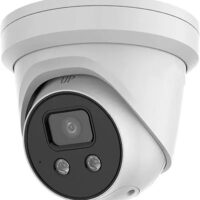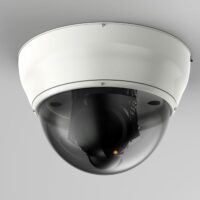——
When it comes to security camera systems, two popular options are turret and dome cameras. Both types offer unique features and benefits, making them suitable for a variety of surveillance needs. However, understanding the critical differences between these two can help you make an informed decision based on your specific requirements. This article will delve into the specifics of each camera type, comparing their effectiveness in security, low-light conditions, installation ease, zoom capabilities, and how they fare against popular brands like Hikvision and Mammoth Security Inc.
Turret and bullet cameras are both excellent choices for security surveillance, each with its advantages. Turret cameras, also known as “eyeball” cameras, have a ball-and-socket type design that allows for a wide range of motion. This flexibility makes them ideal for covering large areas or multiple angles. On the other hand, bullet cameras are more streamlined and compact, making them less noticeable and, therefore, a good choice for discreet surveillance.
Infrared (IR) and night vision capabilities are crucial elements to consider when choosing a surveillance camera. Both turret and dome cameras often come equipped with these features, but their performance may vary. Turret cameras typically have better IR capabilities due to their design, which avoids the reflection issues that dome cameras can encounter with their protective casing. However, many high-quality dome cameras also provide excellent low-light performance.
The installation and angle adjustment of your security camera can significantly impact its effectiveness. Turret cameras are generally easier to install and adjust, thanks to their versatile design. Dome cameras, while slightly more challenging to set up due to their enclosed design, offer a more secure installation that’s less prone to vandalism.
Optical zoom and lens type are key features that determine the clarity of your surveillance footage. While both turret and dome cameras can come with varying degrees of optical zoom, the final decision often comes down to the specific model and manufacturer. It’s essential to consider your surveillance needs when deciding on zoom capabilities – for large, open areas; a higher zoom may be beneficial.


When choosing between brands like Hikvision and Mammoth Security Inc., it’s essential to consider their reputation, product range, and customer reviews. Both brands offer high-quality turret and dome cameras with a range of features. Hikvision is known for its innovative technology and robust products, while Mammoth Security Inc. has a strong focus on customer satisfaction and product reliability. The right choice will depend on your specific needs and preferences.
——
Security camera systems play a crucial role in maintaining the safety and security of premises. Among the myriad of options available, dome and turret cameras are two prominent choices. Each offers unique features and benefits, making them apt for different surveillance scenarios. This article aims to dissect the technical characteristics of these two camera types. By comparing their durability, IP security advantages, suitability for outdoor use, image clarity, sensor technology, and compatibility with security systems, we will provide a comprehensive guide to help you select the most suitable option for video surveillance.
Durability and vandal resistance are pivotal factors when selecting a security camera. Turret cameras, with their robust construction, offer high durability. Their unique design makes them harder to reorient or damage, thereby providing excellent vandal resistance. Conversely, dome cameras, due to their enclosed design, are well-protected against environmental elements and vandalism attempts. Their low-profile appearance also makes them less noticeable, adding a layer of discreetness to their security function.
IP cameras have revolutionized video surveillance by offering superior image quality, remote accessibility, and scalability. Both dome and turret cameras can be designed as IP cameras, with each offering distinct advantages. Dome IP cameras, with their sleek design, can blend seamlessly into any environment, making them ideal for indoor surveillance. Turret IP cameras, on the other hand, offer a more flexible solution for monitoring large areas with their adjustable viewing angles.
The choice between dome and turret cameras for commercial security often depends on the specific surveillance environment. For outdoor use, turret cameras, with their sturdy construction and excellent IR capabilities, are often the preferred choice. They perform well in various weather conditions and provide clear images even in low-light situations. Dome cameras, due to their discreet appearance and vandal-resistant design, are typically favored for indoor commercial spaces.
The quality of video surveillance is primarily determined by the camera’s image sensor and associated technology. Both turret and dome cameras can be equipped with high-quality sensors that deliver clear and detailed images. However, turret cameras often have an edge in low-light conditions due to their design, which reduces glare and reflection. Dome cameras, on the other hand, may offer superior performance in well-lit indoor environments.
Integration with existing security systems is another critical consideration. Most modern dome and turret cameras are designed to work seamlessly with a wide range of security systems. This allows for easy installation, operation, and maintenance, making both types of cameras versatile choices for enhancing your security infrastructure.
——
Selecting the right surveillance camera requires a thorough understanding of various factors, including camera features, installation requirements, physical protection, technological capabilities, and connectivity options. This article aims to shed light on these aspects, specifically focusing on two popular camera types: turret and dome cameras. By discussing their essential features, installation tips, physical protection, enhanced night vision capabilities, and connectivity options, we aim to provide readers with a comprehensive guide to help them make an informed decision.
When comparing turret and dome cameras, it is crucial to evaluate the essential features like zoom, night vision, and resolution. These aspects directly influence the effectiveness of the surveillance system. Dome cameras typically come with variable zoom options, allowing for close monitoring of specific areas. Meanwhile, turret cameras are often equipped with superior night vision capabilities due to their design, which reduces glare and reflection. Both cameras can offer high-resolution video, but the final quality depends on the specific model and manufacturer.
Proper installation and maintenance are crucial to ensuring the long-term performance of both turret and dome cameras. Turret cameras are generally easier to install and adjust due to their versatile design. Dome cameras, on the other hand, require a more careful installation process but offer a secure setup that’s less prone to vandalism. Regular maintenance, including cleaning and checking for any signs of damage, is essential to ensure optimal performance.
Physical protection is another essential factor when choosing between turret and dome cameras. Dome cameras come with a protective glass casing, which not only enhances their aesthetic appeal but also provides a certain level of protection. Turret cameras, on the other hand, are often housed in vandal-proof casings, which offer superior protection against physical damage.
Infrared (IR) technology plays a significant role in enhancing the night vision capabilities of surveillance cameras. Turret cameras, with their unique design, often have better IR capabilities, offering clear images even in low-light or no-light conditions. This makes them an excellent choice for areas requiring round-the-clock surveillance.
In today’s interconnected world, network connectivity and remote monitoring are crucial features of any surveillance system. Both turret and dome cameras come with options for wired or wireless connectivity, depending on the specific model. This allows for easy integration with existing security systems and enables remote monitoring, adding an extra layer of convenience and control to your surveillance setup.
——
Turret cameras offer a compact and less conspicuous design, in contrast to the larger and more prominent housing of dome cameras.
Generally, turret cameras have superior night vision capabilities, attributable to their design and IR illuminator placement.
Indeed, the flexible mounting design of turret cameras allows for more straightforward angle adjustments compared to dome cameras.
Yes, dome cameras typically have a higher resistance to vandalism due to their compact, dome-shaped housing and the camera lens placement behind a protective cover.
Both types can be installed outdoors, but it’s crucial to select models specifically designed for outdoor use to guarantee durability and weather resistance.
Turret cameras often provide better surveillance coverage due to easy angle adjustments, superior night vision, and glare reduction thanks to the turret housing design.
Yes, turret cameras are typically more efficient at reducing glare effects, owing to the design of the turret housing that minimizes unwanted reflections.
Bullet cameras usually have a longer, cylindrical housing, while turret cameras showcase a more compact and sleek design, often featuring a turret-shaped lens cover.
Consider factors such as ease of installation, night vision capabilities, vandalism resistance, and viewing angle adaptability when comparing bullet and turret cameras.
For indoor surveillance, dome cameras are often chosen due to their compact and discreet housing, making them less intrusive indoors.
——